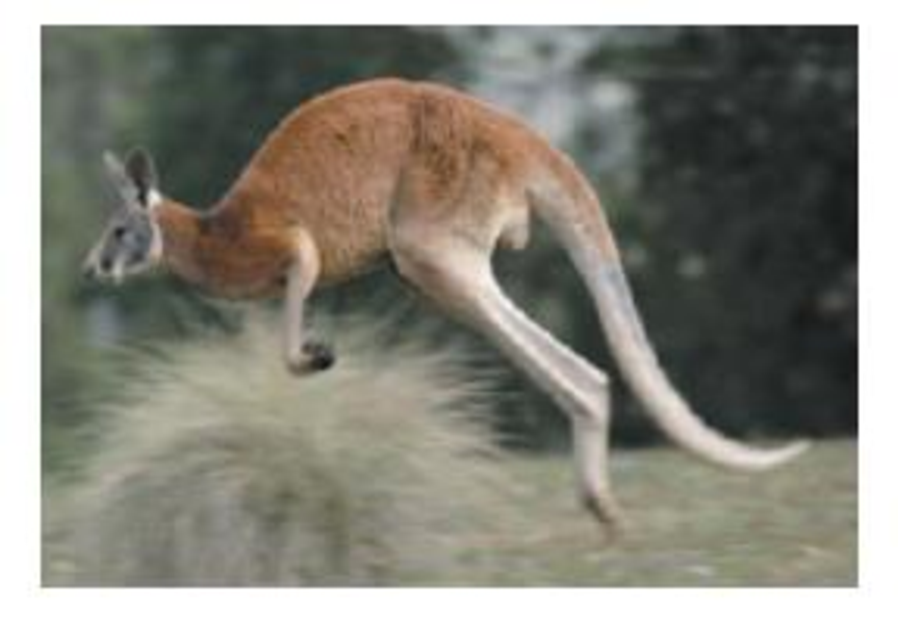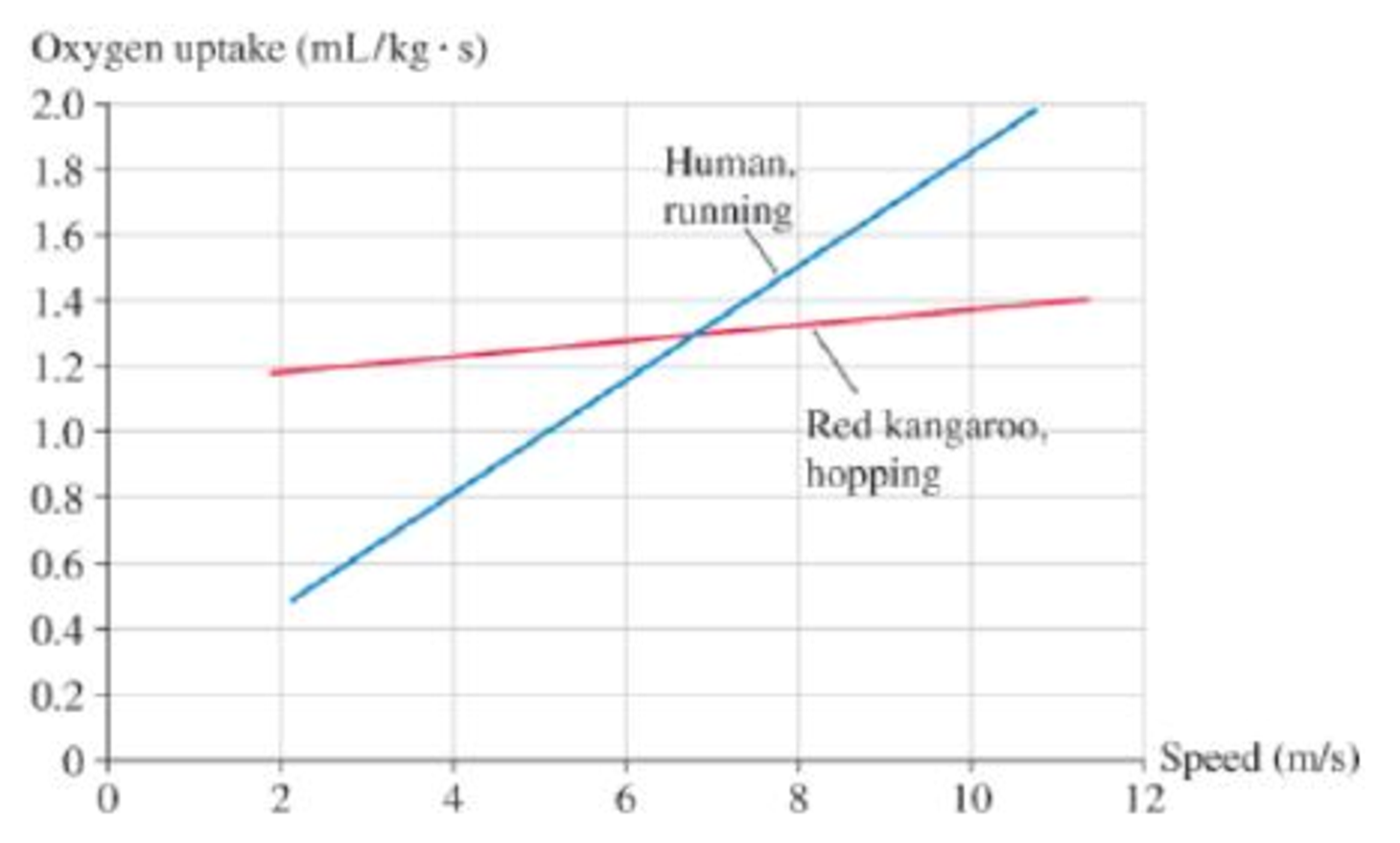
Concept explainers
MCAT-Style Passage Problems
Kangaroo Locomotion

Kangaroos have very stout tendons in their legs that can be used to store energy. When a kangaroo lands on its feet, the tendons stretch, transforming kinetic energy of motion to elastic potential energy. Much of this energy can be transformed back into kinetic energy as the kangaroo takes another hop. The kangaroo’s peculiar hopping gait is not very efficient at low speeds but is quite efficient at high speeds.
Figure P11.68 shows the energy cost of human and kangaroo locomotion. The graph shows oxygen uptake (in mL/s) per kg of body mass, allowing a direct comparison between the two species.
Figure P11.68 Oxygen uptake (a measure of energy use per second) for a running human and a hopping kangaroo.

For humans, the energy used per second (i.e., power) is proportional to the speed. That is, the human curve nearly passes through the origin, so running twice as fast takes approximately twice as much power. For a hopping kangaroo, the graph of energy use has only a very small slope. In other words, the energy used per second changes very little with speed. Going faster requires very little additional power. Treadmill tests on kangaroos and observations in the wild have shown that they do not become winded at any speed at which they are able to hop. No matter how fast they hop, the necessary power is approximately the same.
At a speed of 4 m/s,
A. A running human is more efficient than an equal-mass hopping kangaroo.
B. A running human is less efficient than an equal-mass hopping kangaroo.
C. A running human and an equal-mass hopping kangaroo have about the same efficiency.
Want to see the full answer?
Check out a sample textbook solution
Chapter 11 Solutions
Mastering Physics with Pearson eText -- Standalone Access Card -- for College Physics: A Strategic Approach (3rd Edition)
Additional Science Textbook Solutions
Organic Chemistry (8th Edition)
Human Biology: Concepts and Current Issues (8th Edition)
Campbell Biology: Concepts & Connections (9th Edition)
Physics for Scientists and Engineers: A Strategic Approach, Vol. 1 (Chs 1-21) (4th Edition)
Microbiology: An Introduction
Campbell Essential Biology (7th Edition)
- Which of the following best describes how to calculate the average acceleration of any object? Average acceleration is always halfway between the initial acceleration of an object and its final acceleration. Average acceleration is always equal to the change in velocity of an object divided by the time interval. Average acceleration is always equal to the displacement of an object divided by the time interval. Average acceleration is always equal to the change in speed of an object divided by the time interval.arrow_forwardThe figure shows the velocity versus time graph for a car driving on a straight road. Which of the following best describes the acceleration of the car? v (m/s) t(s) The acceleration of the car is negative and decreasing. The acceleration of the car is constant. The acceleration of the car is positive and increasing. The acceleration of the car is positive and decreasing. The acceleration of the car is negative and increasing.arrow_forwardWhich figure could represent the velocity versus time graph of a motorcycle whose speed is increasing? v (m/s) v (m/s) t(s) t(s)arrow_forward
- Unlike speed, velocity is a the statement? Poisition. Direction. Vector. Scalar. quantity. Which one of the following completesarrow_forwardNo chatgpt pls will upvote Already got wrong chatgpt answerarrow_forward3.63 • Leaping the River II. A physics professor did daredevil stunts in his spare time. His last stunt was an attempt to jump across a river on a motorcycle (Fig. P3.63). The takeoff ramp was inclined at 53.0°, the river was 40.0 m wide, and the far bank was 15.0 m lower than the top of the ramp. The river itself was 100 m below the ramp. Ignore air resistance. (a) What should his speed have been at the top of the ramp to have just made it to the edge of the far bank? (b) If his speed was only half the value found in part (a), where did he land? Figure P3.63 53.0° 100 m 40.0 m→ 15.0 marrow_forward
 Physics for Scientists and Engineers with Modern ...PhysicsISBN:9781337553292Author:Raymond A. Serway, John W. JewettPublisher:Cengage Learning
Physics for Scientists and Engineers with Modern ...PhysicsISBN:9781337553292Author:Raymond A. Serway, John W. JewettPublisher:Cengage Learning Physics for Scientists and EngineersPhysicsISBN:9781337553278Author:Raymond A. Serway, John W. JewettPublisher:Cengage Learning
Physics for Scientists and EngineersPhysicsISBN:9781337553278Author:Raymond A. Serway, John W. JewettPublisher:Cengage Learning Physics for Scientists and Engineers, Technology ...PhysicsISBN:9781305116399Author:Raymond A. Serway, John W. JewettPublisher:Cengage Learning
Physics for Scientists and Engineers, Technology ...PhysicsISBN:9781305116399Author:Raymond A. Serway, John W. JewettPublisher:Cengage Learning College PhysicsPhysicsISBN:9781938168000Author:Paul Peter Urone, Roger HinrichsPublisher:OpenStax College
College PhysicsPhysicsISBN:9781938168000Author:Paul Peter Urone, Roger HinrichsPublisher:OpenStax College
 An Introduction to Physical SciencePhysicsISBN:9781305079137Author:James Shipman, Jerry D. Wilson, Charles A. Higgins, Omar TorresPublisher:Cengage Learning
An Introduction to Physical SciencePhysicsISBN:9781305079137Author:James Shipman, Jerry D. Wilson, Charles A. Higgins, Omar TorresPublisher:Cengage Learning





